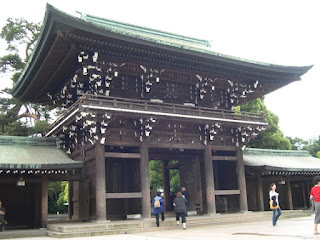 |
| 40-foot high gate entrance to the park |
Shinto is considered Japan's ancient, original religion and it is deeply rooted in the Japanese way of life. This Shinto shrine was built after the death of Emperor Meiji and Empress Shoken, as a memorial to the emperor. The Emperor passed away in 1912, and the Empress in 1914. 100,000 trees from all over Japan and overseas were donated to build a forest to commemorate the Emperor and Empress. In 1920, a shrine was erected in the middle of this forest of 245 different species of trees.
 |
| Forest Surrounding Meiji Shrine |
 |
| One of the many large trees in the middle of the shrine |
 |
| Treasure museum |
The shrine also includes a treasure museum (Homotsuden Honkan), which is open only on Saturdays, Sundays, and national holidays. Admission costs 500 yen per person, 200 yen for high school students, but 300 yen and 100 yen respectively in a group over 20. Middle school children and younger have free admission. This site is valuable because it clearly shows how much Westernization impacted Japan during the Meiji period, and how Meiji himself was fond of Western culture.
Spring Festival

The Meiji Shrine Spring Grand Festival is held at the shrine from April 29th to May 3rd. During this time, several solemn Shinto ceremonies are held. During this festival, various traditional Japanese performances are performed in honour of the deities on the stage in front of the main shrine building. These are open to the public and include Hogaku and Hobu (classical Japanese dance), Bugaku (ancient imperial court music), Sankyoku (traditional Japanese music), Noh and Kyogen (classical Japanese theatre), and Satsuma biwa (Japanese lute music).
Websites: http://www.meijijingu.or.jp/english/, http://studenttrip.wordpress.com/2011/10/31/travel-to-do-list-6-tokyo/

No comments:
Post a Comment